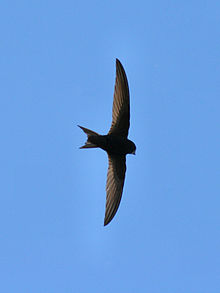SWIFT
| Swift Temporal range: Eocene to present |
|
|---|---|
 |
|
| Common swift, Apus apus | |
| Scientific classification | |
| Kingdom: | Animalia |
| Phylum: | Chordata |
| Class: | Aves |
| Order: | Apodiformes |
| Family: |
Apodidae Hartert, 1897 |
| Subfamilies | |
The swifts are a family, Apodidae, of highly aerial birds. They are superficially similar to swallows, but are not closely related to any of the passerine species. Swifts are placed in the order Apodiformes, which they share with hummingbirds. The treeswifts are closely related to the true swifts, but form a separate family, the Hemiprocnidae.
Resemblances between swifts and swallows are due to convergent evolution, reflecting similar life styles based on catching insects in flight.
The family name, Apodidae, is derived from the Greek ἄπους (ápous), meaning "footless", a reference to the small, weak legs of these most aerial of birds. The tradition of depicting swifts without feet continued into the Middle Ages, as seen in the heraldic martlet.
Some species of swifts are among the fastest animals on the planet, with some of the fastest measured flight speeds of any bird.
Taxonomists have long classified swifts and treeswifts as relatives of the hummingbirds, a judgment corroborated by the discovery of the Jungornithidae (apparently swift-like hummingbird-relatives) and of primitive hummingbirds such as Eurotrochilus. Traditional taxonomies place the hummingbird family (Trochilidae) in the same order as the swifts and treeswifts (and no other birds); the Sibley-Ahlquist taxonomy treated this group as a superorder in which the swift order was called Trochiliformes.
The taxonomy of the swifts is complicated, with genus and species boundaries widely disputed, especially amongst the swiftlets. Analysis of behavior and vocalizations is complicated by common parallel evolution, while analyses of different morphological traits and of various DNA sequences have yielded equivocal and partly contradictory results.
...
Wikipedia
